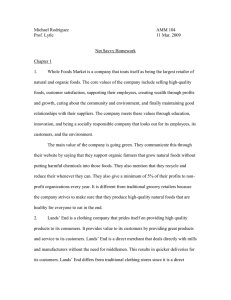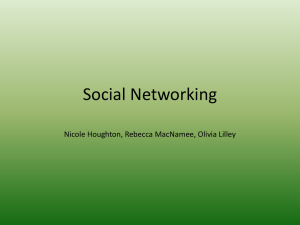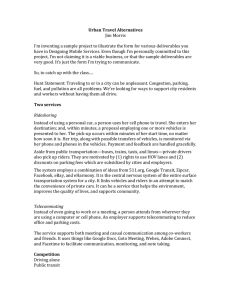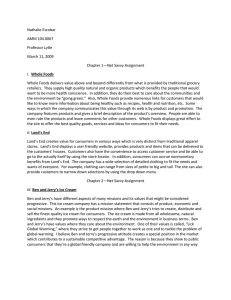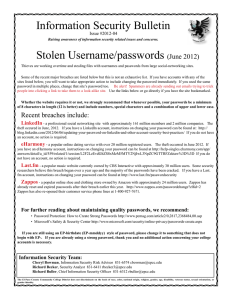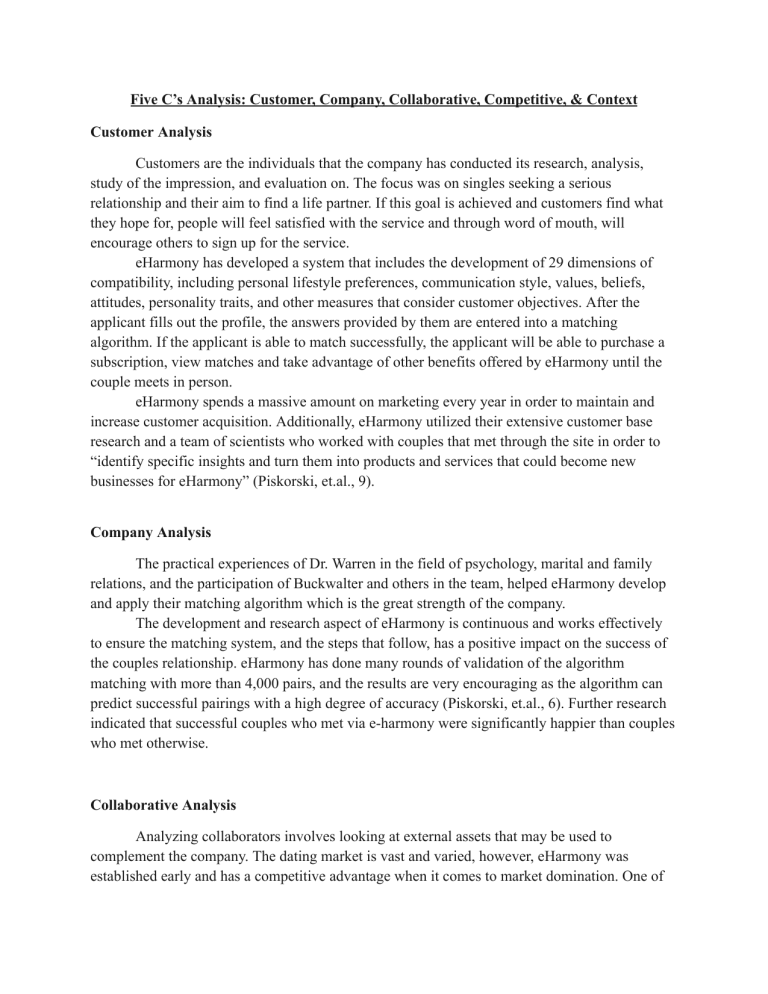
Five C’s Analysis: Customer, Company, Collaborative, Competitive, & Context Customer Analysis Customers are the individuals that the company has conducted its research, analysis, study of the impression, and evaluation on. The focus was on singles seeking a serious relationship and their aim to find a life partner. If this goal is achieved and customers find what they hope for, people will feel satisfied with the service and through word of mouth, will encourage others to sign up for the service. eHarmony has developed a system that includes the development of 29 dimensions of compatibility, including personal lifestyle preferences, communication style, values, beliefs, attitudes, personality traits, and other measures that consider customer objectives. After the applicant fills out the profile, the answers provided by them are entered into a matching algorithm. If the applicant is able to match successfully, the applicant will be able to purchase a subscription, view matches and take advantage of other benefits offered by eHarmony until the couple meets in person. eHarmony spends a massive amount on marketing every year in order to maintain and increase customer acquisition. Additionally, eHarmony utilized their extensive customer base research and a team of scientists who worked with couples that met through the site in order to “identify specific insights and turn them into products and services that could become new businesses for eHarmony” (Piskorski, et.al., 9). Company Analysis The practical experiences of Dr. Warren in the field of psychology, marital and family relations, and the participation of Buckwalter and others in the team, helped eHarmony develop and apply their matching algorithm which is the great strength of the company. The development and research aspect of eHarmony is continuous and works effectively to ensure the matching system, and the steps that follow, has a positive impact on the success of the couples relationship. eHarmony has done many rounds of validation of the algorithm matching with more than 4,000 pairs, and the results are very encouraging as the algorithm can predict successful pairings with a high degree of accuracy (Piskorski, et.al., 6). Further research indicated that successful couples who met via e-harmony were significantly happier than couples who met otherwise. Collaborative Analysis Analyzing collaborators involves looking at external assets that may be used to complement the company. The dating market is vast and varied, however, eHarmony was established early and has a competitive advantage when it comes to market domination. One of eHarmony’s collaborators is the market's overall technological advancement. eHarmony integrated many online features that enhanced the user experience, such as screening preferences and video calling. Another external asset that eHarmony had was word of mouth marketing. In 200, a Christian radio program featured eHarmony on their broadcast. The religiously affiliated program felt that “eHarmony’s focus on serious relationships would resonate well with the Christian community—a market segment also untapped by traditional dating sites” (Piskorski, et.al., 4). This positive word of mouth gave potential customers insight into just how the site matched users and what kind of relationships new users could expect. Competitive Advantage When it comes to the competitive advantage of the online dating sphere, each potential competitor wants to ‘win’ the customer acquisition. eHarmony had its share of direct competitors and many indirect competitors as well such as, free & paid do-it-your-self sites, niche sites, and social networking platforms. eHarmony’s differentiation in the market comes from its personality profile, which claims to accurately match compatible individuals. The personality profile questionnaire takes a considerable amount of time, about 45 minutes to complete. This lengthy questionnaire discouraged a number of potential users from joining the site, with men being less likely to complete the form. Contrary to eHarmony, Match had only a brief set of questions and fewer barriers when it came to registering with the platform. Furthermore, the emergence of free dating sites, such as ‘Plenty of Fish’ took a good portion of the dating customer base away from eHarmony, as “the website received 20% more visits than eHarmony did” simply because of the zero dollar subscription cost (Piskorski, et.al., 10). Social media sites, such as Facebook and Instagram also threatened eHarmony’s market share. The large user base of these platforms made interacting with and reaching out to individuals online a daunting task. Initially, online messaging and unlimited profile browsing were features built into social media sites like Instagram and Facebook. This drew customers to use these platforms as a means to seek out romantic relationships and as a result, these companies were able to grow in the relationship segment with a much smaller marketing budget than that of eHarmony.Additionally, eHarmony initially did not offer matches to users seeking same sex relationships, whereas social media sites allowed you to connect with friends & those with similar interests and preferences as you, making it easier for individuals to connect, regardless of orientation. Match attempted to grow their user base by offering additional platforms and services in addition to their original product. Match introduced ‘Chemistry’, which was aimed at competing with eHarmony’s serious relationship crowd, but unlike eHarmony “Chemistry sold memberships to anyone who wished to sign-up […] Chemistry claimed that its algorithm focused on interpersonal chemistry rather than psychosocial compatibility” (Piskorski, et.al.,12). As such, eHarmony must decide how to counter their competitors actions in order to expand its user base while retaining profits and positive market buzz. Context Analysis It's important as a company to have context when it comes to cultural & market trends as “many fortunes are made by anticipating cultural trends” (Piskorski, et.al., 13). Understanding the modern dating market to begin with was one of eHarmony’s priorities when creating their dating service. Learning that divorce rates and the average age of couples getting married were rising over the years allowed eHarmony to specifically market to certain age groups and demographics. The systems that were implemented, such as the personal profile, matching algorithm, and the Guided Communication system, were created while keeping the context of the modern-day marriage market in mind. For example, eHarmony refuses to sell memberships to those who are already married, those who are underage, and those who have been divorced more than three times. According to their research, this level of exclusivity yielded better results for users of eHarmony seeking a long-term partner. Four P’s Analysis: Product, Promotion, Place, & Price Product The product offering is best conceptualized as the complete set of ways that a firm delivers value to its chosen customers. eHarmony has risen to the top with its commitment to creating genuine connections in the online dating world. The product utilizes advanced features such as the personality profile, matching algorithm, and guided communication, to curate accurate matches for each customer. The personality profile consists of 258 questions covering, “29 basic measures of compatibility, including personal lifestyle preferences, communication style, values, beliefs, attitudes, personality traits, family background, birth order, energy level, intelligence, spirituality, special interests, and future aspirations” (Piskorski, et.al., 5). eHarmony felt this process would reduce the amount of potential non-serious customers. The matching algorithm delivered matches that were best suited for each individual based upon the data from the personality tests. The company secured a patent for the algorithm in 2004. eHarmony believes that if the product is able to produce genuine matches then the rate of subscriptions would increase as “everyone has an implicit dollar amount they are willing to pay for a match” (Piskorski, et.al, 6). eHarmony also has a function, Guided Communication, that leads customers into deeper conversations after matching. Guided Communication offers a series of questions that allows for a deeper connection amongst each other prior to Open Communication. The series of product designs distinguishes eHarmony to opposing online dating platforms. eHarmony attributes the success to the exclusivity of the product that in 2007 boasted a success rate that found “on average, 236 eHarmony members marry every day in the United States as a result of being matched on eHarmony, representing a stunning 2% of marriages in America” (Piskorski, et.al., 8). Promotion Promotion utilizes the 6 M’s: market, mission, message, media, money, and measurement to convey the direction of the company. eHarmony has a mission to serve singles committed to finding serious long-term relationships. Furthermore, they seek to convey the message that serious relationships can be found through online dating services. eHarmony remains committed to creating genuine connections amongst its users. In 2007 eHarmony debuted a direction for its marketing. The new campaign featured couples who found love on eHarmony, shot in their real environment in a documentary style. It was dedicated to highlighting each couple's love story. eHarmony advertised exclusively on national cable networks, as it allowed for greater marketability. About 75 percent of the total marketing budget was spent on television and radio. A total that accumulated to about 80 million dollars (Dolan, 8). In 2007 eHarmony contributed a great deal of efforts and funds to establishing a research and development team, eHarmony Labs. The eHarmony Labs were tasked with studying the biological, sociological, and neurological roots of love. In order to continue the development and enhance the experience for the users, a five year study of over 400 couples was conducted. The study sought to follow the couples after marriage during life “to identify what characteristics and behaviors in couples predicted successful transitions” (Piskorski, et.al., 9). Place Place refers to distribution channels, where and how an organization decides to go to the market. The demand for online services amongst all markets is receiving a new boost. Consumers are more susceptible to doing things from the comfort of their home. Although, the market for online dating services can be seen as risky and not for serious relationships. eHarmony seeks to capitalize on the technology boom, and create a new narrative regarding the online dating services. Other online dating services provide subpar matches and eHarmony utilizes the advanced systems to produce a product that differentiates itself. Furthermore, the product utilizes data to continue to refine the system, for example, reduced personality profile, guided communication, advancement in lab work that seeks to conduct marriage research, etc. eHarmony has found themselves in a growing tech age world that requires a serious dating option. Price The final p of the marketing mix, price, is important as it is essential to the bottom-line & creating value for the customers. The value of eHarmony comes from the personality profile and matching algorithm which allows eHarmony to charge more than their competitors. Despite this, it’s still important to research the market and decide on a posted price, which can be “fairly stable […] or they can be dynamic” depending on the service being offered (Dolan, 33). eHarmony’s marketing budget is one of the biggest expenditures of the company, and to offer the best posted price, it’s important to know what your competitors are charging. Yahoo, for example, launched a premiere service that was $15 more than Yahoo's original product and it was not successful because “Yahoo! did not put significant resources behind the business” (Piskorski, et.al., 13). Picking a price is just as important as how you incorporate that price. eHarmony offered different prices depending on how many months you signed up for, and this can be beneficial to customers who may have different price sensitivity. Works Cited Piskorski, Mikolaj J., Halaburda, Hanna, Smith, Troy. “eHarmony.” Harvard Business School Case, 709-424, July 2008 Dolan, Robert J. “Framework for Marketing Strategy Formation” Harvard Business School Core Curriculum , Jun 30, 2014
